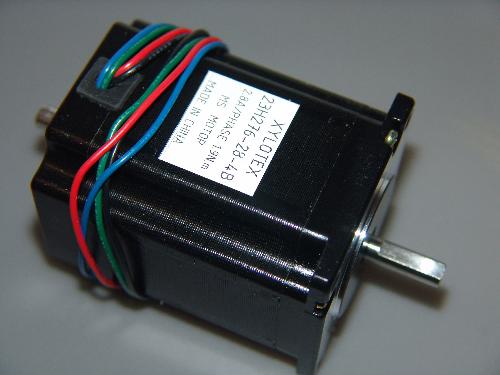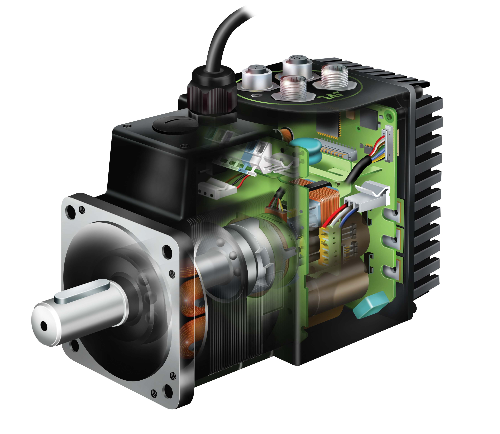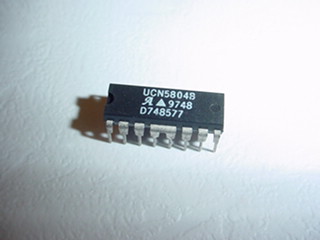Sunday, March 27, 2011
stepper motor Facts
Stepper motors offer many advantages. Although feedback is not usually required, stepper motors are compatible with feedback signals, either analog or digital. Error is noncumulative as long as pulse-to-step integrity is maintained by the stepper motor. A stream of pulses can be counted into stepper motors, and the stepper motor's final position will be known within a small percentage of one step.
Since maximum dynamic torque occurs at low pulse rates, stepping motors can easily accelerate a load. When the desired position is reached and command pulses cease, the stepper motor shaft stops and there is no need for clutches or brakes. The stepper motor is generally left energized at a stop position. Once stopped, the stepper motor resists dynamic movement up to the value of the holding torque. An additional feature of the PM stepper motor is that when all power is removed, it is magnetically detented in the last position. A wide range of step angles are available -- 1.8 to 80°, for example -- without logic manipulation. Stepper motors have inherent low velocity without gear reduction. A typical stepper motor driven at 500 pps turns at 150 rpm. The stepper motor's rotor inertia is usually low. Multiple stepper motors driven from the same source maintain perfect synchronization.
But the stepper motor's efficiency is low; much of the input energy must be dissipated as heat. Load must be analyzed carefully for optimum stepper motor performance. And inputs must be matched to the stepper motor and load. Damping may be required when load inertia is exceptionally high to prevent oscillation.
Servo Motor vs Stepper motor
Stepper motors follow a laundry list of x/y axis coordinates provided by the controller. The torch proceeds to each point in the file, perhaps a half a thousandth of an inch apart, both axes working in precise synchronization with each other. The relatively simple circuitry involved provides great reliability, good low speed torque, and easy set-up. Positioning errors don't occur, since stepper motors know in advance where they are going and when to stop.
Servo motors depend upon "closed-loop" circuitry to supply information back to the computer so that positioning errors can be continuously corrected. This feedback is provided by encoders, which in some respects, are like the bicycle wheels that some road builders and others use to measure distances.
A new type of servo motor called an "intelligent servo motor" has recently appeared on the scene. It is useful for some applications, and we use it in our automatic torch height controls. In fact, we probably purchase more of them than any of our competitors. The motor has some programmable computer circuitry incorporated into it, which lets it independently follow simple instructions. It works well with our torch height controls, due to their low torque demand. We believe intelligent motors are impractical for driving a cnc machine, for reasons given below.
The following paragraphs explain each of these types of motors in more detail.
Stepper Motors
Stepper motors are relatively inexpensive, and provide the same or greater accuracy as servo motors. Sufficiently powerful stepper motors for a given application do not lose steps. Stepper motors are no more likely to lose steps than a servo encoder is to pass bad information back to the controller. This hoax is pure hype generated by manufacturers who are either unfamiliar with stepper motors, or who are distorting facts to market their particular product. If for some reason a stepper motor does encounter an obstacle it can't overcome, such as a tipped up plate, it will simply skip steps, hurting nothing. If a servo motor encounters the same obstacle, it will sit there and fight itself until it breaks a gear tooth or burns up.
If a stepper motor goes bad, which can happen to all three types of motors, replacement cost is under $200.00. No elaborate tuning process is needed to keep it functioning accurately. Best of all, its excellent low rpm torque lends itself perfectly to cnc plasma and oxy-fuel shape cutting, without the need for backlash producing gearboxes. The low speed torque makes it possible to use a timing belt and pulley reduction, with virtually no backlash.
Bear in mind that the vast majority of cnc cutting movements with stepper motors are at less than 300 rpm motor speed, which translates to about 130 inches per minute on Torchmate machines. Cutting speeds and rapid traverse moves up to about 350 inches per minute are possible, although cutting would rarely require speeds in excess of 150 inches per minute. Rapid traverse moves faster than 350 inches per minute are virtually never needed, as the distance between pieces being cut rarely provides sufficient time for ramping (acceleration and deceleration). Don't be taken in by claims of super fast speeds. The more important issue in cnc plasma and oxy-fuel applications is how slow a move a machine can make. Oxy-fuel cutting of thick steel can require speeds as slow as 2 or 3 inches per minute.
The use of dual X axis motors is easier and more precise with stepper motors than with intelligent motors, which require instructions to be passed along from motor to motor in kind of a daisy chain, rather than directly to both motors from the controller. With steppers, the two motor drivers receive identical simultaneous instructions from the computer, one in reverse of the other, reducing the chance of mis-communication.
Servo Motors
Servo motors are somewhat more expensive than steppers -- perhaps double the price, or more. They are generally just as accurate, if maintained in a proper state of tune, however they rely on encoders to provide positioning information back to the computer. Thus the complexity of the system is at least doubled, with no accuracy advantage, greater initial cost, and more maintenance issues. The "closed loop" rhetoric that some manufacturers play up sounds convincing to the uninitiated, but provides no benefit over a simpler and more reliable stepper system.
Servo motors are available in larger sizes than stepper motors, and powerful servos are generally used on heavy machines with gantry carriages in the 500 to 1,000 lb range. They offer no advantage whatsoever on lighter machines, such as Torchmate and its competitors.
L298 Stepper Motor Driver
This Step motor controller uses the L297 and L298N driver combination; it can be used as stand alone or controlled by microcontroller. It is designed to accept step pulses at up to 25,000 per second. An on-board step pulse generator can be used if desired (40-650 pps range). Single supply operation is standard
All eight inputs are pulled up to +5V by RP1 (4.7K) and are buffered by 74HC244. The output driver is capable of driving up to 2Amp into each phase of a two-phase bipolar step motor. The motor winding current is limited by means of a 35KHZ-chopper scheme. The potentiometer (R6) is for varying the winding currents. The nature of the chopping scheme eliminates the need for external current limiting resistors on the motor windings; this simplifies connections and increases efficiency.
A useful of this design is the “idle” current reduction mode. The amount of reduction is fixed at approximately 50% from whatever the running current is set at. Similarly, the motor current can be commanded to shut entirely off.
The internal +5V voltages required for operation are derived from the stepper motor supply. The motor supply voltages should be at least 9V, but must never exceed 32V.
stepper motor basics
 A stepper motor (or step motor) is a brushless, synchronous electric motor that can divide a full rotation into a large number of steps. The motor's position can be controlled precisely without any feedback mechanism (see Open-loop controller), as long as the motor is carefully sized to the application. Stepper motors are similar to switched reluctance motors (which are very large stepping motors with a reduced pole count, and generally are closed-loop commutated.
A stepper motor (or step motor) is a brushless, synchronous electric motor that can divide a full rotation into a large number of steps. The motor's position can be controlled precisely without any feedback mechanism (see Open-loop controller), as long as the motor is carefully sized to the application. Stepper motors are similar to switched reluctance motors (which are very large stepping motors with a reduced pole count, and generally are closed-loop commutated.
Subscribe to:
Comments (Atom)




